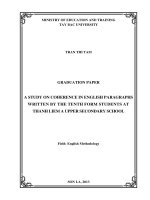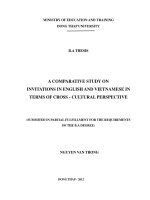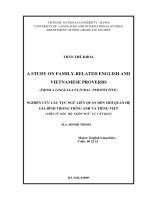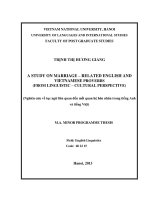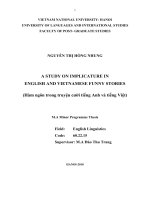A study on subordinators in english and vietnamese
Bạn đang xem bản rút gọn của tài liệu. Xem và tải ngay bản đầy đủ của tài liệu tại đây (464.54 KB, 50 trang )
i
DECLARATION
I, Lê Thị Thu Hiền, state that this graduation paper is the result of my own
study. The whole content in the study has not been submitted from any other studies.
Lê Thị Thu Hiền
Jan, 2013
ii
ACKNOWLEDGEMENTS
I would like to express my sincere gratitude to my supervisor, Đặng
Nguyên Giang, M.A for his valuable guidance, helpful advice, suggestions and
encouragement in the process of writing my graduation paper.
I am thankful to all of my teachers in the Foreign Language Department for
their kindness and assistance during the process of the study.
My sincere thanks also go to my friends who have given me useful advice and
ideas.
I greatly appreciate the support and encouragement from my family.
iii
ABSTRACT
In this study, I used of the English as the source language and the
Vietnamese language as the target one. The process can be divided into two
stages:
First, materials containing relevant information for the study such as
grammar book, previous studies, information on the internet…in both languages
will be collected, and the main characteristics of subordinators in English and
Vietnamese are described. Then, techniques of analysis and statistics are applied
to find out the positions, grammatical features and semantic implication of
subordinators in both languages.
Then, basing on the results from the stage 1, comparison and contrastive
analysis are applied to find out the similarities and the differences between
English and Vietnamese in terms of subordinators.
iv
TABLE OF CONTENTS
DECLARATION i
ACKNOWLEDGEMENTS ii
ABSTRACT………………………………………………….….……………………………iii
TABLE OF CONTENTS iv
PART A: INTRODUCTION 1
1. Rationale 1
2. Aims and Objectives of the Study 2
3. Research Questions 2
4. Scope of the Study 2
5. Methodology 3
6. Materials Used 3
7. Design of the Study 3
PART B: DEVELOPMENT 5
CHAPTER 1: LITERATURE REVIEW 5
1. Theoretical Background 5
1.1. What is Meant by “Subordination”? 5
1.2. What is Meant by “Subordinator”? 6
1.3. Subordinators in the Relationship with Other Connectors 8
1.3.1. Subordinators Versus Coordinators 8
1.3.2. Subordinators Versus Conjunctive Adverbs 9
2. Review of Previous Works 11
3. Summary 13
CHAPTER 2: SUBORDINATORS IN ENGLISH AND VIETNAMESE 14
1. Subordinators in English 14
1.1. Simple Subordinators 14
v
1.1.1 . Subordinators of Time clause 14
1.1.2. Subordinators of Cause and Effect 16
1.1.3. Subordinators of Concession 17
1.1.4. Subordinators of Condition 19
1.2. Compound Subordinators 21
1.2.1. Compound Subordinators Ending with that 21
1.2.2. Compound Subordinators Ending with Optional that 23
1.2.3. Compound Subordinators Ending with as 25
1.3. Correlative Subordinators 27
2. Subordinators in Vietnamese 29
2.1. Subordinators of Concession 29
2.2. Subordinators of Reason 31
2.3. Subordinators of Purpose 33
2.4. Subordinators of Condition 34
3. Summary 35
CHAPTER 3: SIMILARITIES AND DIFFERENCES BETWEEN ENGLISH AND
VIETNAMESE IN TERMS OF SUBORDINATORS 36
1. Features of Subordinators Found in Both languages 36
1.1. Positions of Simple Subordinators in Sentences 36
1.2. Semantic Implication of Subordination by Subordinators 37
2. Features of Subordinators Unique to English 39
3. Features of Subordinators Unique to Vietnamese 39
3.1. Subject Ellipsis 40
3.2. Forming Simple Subordinators into Correlative Subordinators 40
4. Summary 40
PART C: CONCLUSION 41
1. Recapitulation 41
vi
2. Conclusions 41
3. Implementations for language teaching and learning 42
4. Suggestions for further studies 43
REFERENCES 44
1
PART A: INTRODUCTION
1. Rationale
It cannot be denied that the role of English in our lives has got much
importance. It is used as the most common language for all parts of the world
nowadays. Moreover, it is a means to link all cultures and bring a huge treasure
of knowledge to human being, especially in science and technology. Awaring of
the role of English in modern world, English has been taught for every
educational level. In the recent years, the quality of teaching and learning has
been improved a lot by some educational reform policies of Ministry of
Education and Training.
It is believed that the purpose of learning foreign language is to
communicate successfully with foreigners. However, it seems difficult for
people to be successful in communicating in any foreign languages if they do
not understand clearly and exactly its grammar. In other words, understanding
the grammar is the base of the success in using foreign language. However,
English appears much different from Vietnamese in variety of aspects. This
causes many difficulties for Vietnamese learners and teachers in teaching and
learning this language.
Subordinators are regarded as a kind of connectors that are used to connect
different parts in sentences. Subordinators play a very important role in building
successful sentences in particular and in writing English in general. However, it
can be said that Vietnamese learners have many troubles in writing and
translating English, especially using subordinators in sentences. To my best of
my knowledge, this problem has not been found in any works on subordinators
before. This is the reason why the author decides to make a minor study on this
topic with the hope that this would give a small part to help teachers and
learners to get the best result in teaching and learning English subordinators.
2
2. Aims and Objectives of the Study
The study, as entitled, focus on subordinators in English and Vietnamese;
therefore, the main aim of this study is to work out the similarities and the
differences between English and Vietnamese in terms of subordinators.
In order to achieve the aims, the study is expected to reach the following
objectives:
- to study how subordinators are organized structurally and semantically in
English and Vietnamese;
- to establish the similarities and differences between English and
Vietnamese in terms of subordinators.
3. Research Questions
The objectives of the study can be elaborated into the following research
questions:
- How are English and Vietnamese subordinators organized structurally and
semantically?
- What are the similarities and differences between English and Vietnamese
in terms of subordinators?
4. Scope of the Study
This study does focus on the subordinator (used to connect clauses in
sentences) in English and Vietnamese. Due to the scope of the graduation paper
as well as the limited knowledge of the author, we would like to pay attention to
the following aspects:
- Positions in sentences
- Grammatical features
- Semantic implication of subordination by subordinators.
3
5. Methodology
Due to the main aims and objectives of the study, describing, analyzing,
contrasting, and comparing would be mainly carried our throughout the process.
Also, the study makes use of English as the source language and the Vietnamese
language as the target one. The process can be divided into four stages.
Stage 1: A theoretical framework suggested by Quirk and Greenbaum
(1973) is applied in the present study.
Stage 2: Materials containing relevant information for the study such as
grammar books, previous studies, information on the internet, etc in both
languages will be collected, and the main characteristics of subordinators in
English and Vietnamese are described and analyzed.
Stage 3: After collecting data, techniques of description and analysis are
applied to find out the positions, grammatical features and semantic implication
of subordinators in both languages.
Stage 4: Basing on the results from the stage 3, comparison and contrastive
analysis are applied to find out the similarities and the differences between
English and Vietnamese in terms of subordinators.
6. Materials Used
In this study, the author uses the following materials:
- Monolingual English and Vietnamese books
- Bilingual English – Vietnamese books
- Information on internet
- Dictionaries
7. Design of the Study
The study consists of three parts, excluding the references.
Part A, introduction, consists of the rational, the aims and objectives,
research questions, the scope, the method and the design of the study.
4
Part B, development, is the main part of the study. This part is divided into
3 chapters: Chapter 1: Literature review, Chapter 2: Subordinators in English
and Vietnamese, and Chapter 3: The similarities and differences between
English and Vietnamese in terms of subordinators.
Part C, the last past, is the conclusion. This part consists of recapitulation,
conclusions, implication for teaching and learning English subordinators and
suggestions for further studies.
5
PART B: DEVELOPMENT
CHAPTER 1: LITERATURE REVIEW
1. Theoretical Background
1.1. What is Meant by “Subordination”?
There are two most popular kinds of relationship in the sentences in both
English and Vietnamese: subordination and coordination. In other words, most
sentences are formed by subordination and coordination of components.
Subordinations are definited by some grammarians.
According to Quirk, Greenbaum (1973), subordination is a non-
symmetrical relation, holding between two clauses in such a way that one is
constituent or part of the other. In linguistics, subordination is a principle of
the hierarchical organization of linguistics units. While the principle is
applicable in semantics, syntax, morphology, most works in linguistics
employs the term “subordination” in the context of syntax, and that is the
context in which it is considered here. The syntactic units of sentences are
often either subordinate or coordinate to each other.
Biber, Conrad and Leech (1999) pointed out some signals of
subordination. According to writers, subordination can be signaled by an
overt link, in the form of a subordinator or Wh-word, and a non-finite verb
phrase, that is, by a verb phrase introduced by an infinitive, present
participle or past participle. Finite clauses are marked for tense or modality.
Finite dependent clauses usually have an overt link, stating with a
subordinator or Wh-word. Look at this example:
(1) You can drink your orange [if you like]
In the example (1), we use if - one of subordinator to connect two
clauses, so the readers or listeners can base on subordinator to recognize
subordination.
6
According to Toán, B.M and Lương, N.T (2007), subordination is
commonly expressed the relationship between subordinate clause and main
clause in a sentence. It has following characteristics:
First, it marks an unequal relationship between two clauses in
subordinating compound sentences, drives one clause become main clause, and
the other is subordinate clause. For example:
(2) Hôm nay tôi nghỉ học vì trời mưa.
(Today I don’t go to school because it rains)
Main clause subordinate clause
Second, in semantical relationship, two events in two clauses are connected
in a control relationship each other, such as this event happened because of
another event, etc. It can be seen in example (2).
The final signal characteristic is that all the subordinated components can
change their order in a sentence. For instance, we can say Hôm nay tôi nghỉ học
vì trời mưa (Today I don’t go to school because it rains) or Vì hôm nay trời mưa
nên tôi nghỉ học (Because it rains, I don’t go to school).
1.2. What is Meant by “Subordinator”?
According to Quirk and Greenbaum (1973), subordinators are perhaps the
most important formal indicators of subordination. Like preposition, which they
resemble in having a relating or connecting function, subordinators form the
core of the class consist of single word, and again, as with prepositions, there are
numerous compound items which act, to various degrees, like a single
conjunction (Quirk and Greenbaum 1973: 313). The writers also state that there
are three types of subordinators (subordinating conjunction): simple
subordinators, compound subordinators and correlative subordinators.
Biber, Conrad and Leech (1999) show that subordinators differ in
important ways from other clause links. Subordinators are like coordinators, but
7
they are different from linking adverbial, because subordinators occur in a fixed
position at the front of their clause.
Oshima and Hogue (1998) claim that subordinators are words and phrases
that signal subordinate clause, introduce dependent subordinate clauses and
signal the relationship between the subordinate clause and the main clause.
Another source shows that subordinators are applied to a grammatical
distinct, close class of words whose primary role is to mark a clause as
subordinate.
In Vietnam, subordinators are considered as particles of empty words and
sentences that show the subordinated relationship. Like English, they are means
of connecting main element and subordinate element. Therefore, subordinators
are likely to connect with subordinate clause elements according to Ban and
Thung (2001). For instance:
(4) Diệp bị đau đầu vì cô ấy suy nghĩ quá nhiều.
(Diep got headache because she thought too much).
In example (4), because joins two clauses Diệp bị đau đầu and cô ấy suy nghĩ
quá nhiều. The two clauses have subordinated relationship in which Diệp bị đau
đầu is the main clause and cô ấy suy nghĩ quá nhiều is subordinate clause.
Sharing the same idea, Toán and Lương (2007) state that subordinators are
empty words and they do not denote things but show the grammatical
relationship between two clauses (main clause and subordinate clause). They are
considered as very important means in connecting two clauses in sentences.
Look at the example below:
Bởi tôi ăn uống điều độ và có chừng mực nên tôi chóng lớn lắm.
(Tô Hoài, ‘Dế mèn phiêu lưu kí’)
(Because I eat in a diet regularly and moderately, I grow very well).
8
1.3. Subordinators in the Relationship with Other Connectors
1.3.1. Subordinators Versus Coordinators
Both subordinators and coordinators have the function of connecting units
in sentences. However, there are many differences between them.
The first difference between subordinators and coordinators is that while
subordinators link unit(s) that is constituent(s) of larger one, units connected
with coordinators stand on equal footing with each other.
E.g.
(1) Whenever we go to the park, I’m always get bitten by mosquitoes.
(2) He was tired, so he went to bed.
As we can see, in the example (1), the dependent clause we go to the park
subordinates to the main clause by subordinator whenever. It can’t stand
independently as a simple sentence but subordinates to the rest clause. On the
contrary, in the example (2), the two clauses are independent. Each of them can
stand separately and act as a simple sentence.
The second difference need mentioning is that when clauses are connected
with coordinators such as and, but, or, subject ellipsis is allowed, subordinators
do not allow subject ellipsis. For example, we can’t say I didn’t buy it although
like it, but we have to say I didn’t buy it although I like it.
In addition, while coordinators can introduce clauses, words, and phrases,
most of subordinators introduce clauses. Though the act area of subordinators is
smaller than coordinators, in semantic term, subordinators are so variety. Let’s
look at these examples:
E.g.
(3) Although she is fat, she eats candies so much. (Concession)
(4) We hurried to school so that we wouldn’t be late. (Purpose)
(5) Since he missed the first bus, he came ten minute late. (Reason)
9
The above sentences illustrate some roles of subordinators in sentences in
term of semantic.
Besides, most of clauses which can change their position are introduced by
subordinators, so they can precede or follow the main clause in complex
sentences. Thus, we can say There are no polluting exhaust gases because it is
electric or Because it is electric, there are no polluting exhaust gases. On the
other hand, the clauses are introduced by subordinators have restricted position;
namely, it always follows the rest clause(s) in compound sentences. Therefore,
we can’t change the sentence He didn’t want to be seen, so he carefully
sauntered off in the opposite direction into So he carefully sauntered off in the
opposite direction, he didn’t want to be seen.
Furthermore, subordinators can be put after coordinator and, but, or and
for, e.g. I don’t go out at night but only if I can use the car. In the following
sentence, two subordinated clauses are joined together with and which precedes
the second subordinator because: He asked to be transferred because he was
unhappy and because he saw no prospect.
The final difference between subordinators and coordinators is that
coordinators usually form looser connections than subordinators do.
E.g.
Mary was late for work and she received a cut in pay. (Very loose)
Mary was late for work; she received a cut in pay. (Loose)
Because Mary was late for work, she received a cut in pay. (The
subordinator because creates a tighter link between the ideas).
1.3.2. Subordinators Versus Conjunctive Adverbs
Subordinators and conjunctive adverbs are two kinds of conjunction among
units in sentences and they are often employed in academic writing. However,
they are different from each other in many points. Students usually meet
10
difficulties in distinguishing them. To make it become clearer, the author would
like to give out some main differences between them.
Firstly, subordinators can show that one idea is more important than
another. The idea in the main clause is more important, and the idea in the
subordinate clause is less important while conjunctive adverbs such as however,
moreover, nevertheless, consequently, as a result,…etc are used to join two
independent clauses. A conjunctive adverb is a word (phrase) that shows how
such sentences, sections of a paragraph, or entire paragraphs are related. They
add a lot of emphasis.
E.g.
(1) Although Diana’s life should have been a happy life, it was not to be.
(2) Natalie loved strawberries; however, they gave her a rash.
It can be seen in the first sentence, subordinator although shows that
Diana’s life should have been a happy life is less important, and the idea It was
not to be is more important. On the other hand, in the second example, however
links two independent clauses Natalie loves strawberries and they gave her a
rash to emphasize that They gave her a rash is contrary to Natalie’s favorite.
Secondly, subordinators are usually a single word, but there are also a
number of multi–word subordinators that function like single subordinating
conjunctions. Subordinators make the clause depend on the rest of the sentence
in order to make sense. A comma at the end of an adverbial phrase when it
precedes the main clause is needed.
E.g. Although she doesn’t like him, she still go out with him.
Usually, no comma is needed before a subordinating conjunction if the
dependent clause follows the independent clause.
E.g. Mary never likes chocolate although it smelled delicious.
To conjunctive adverbs, a semicolon and a comma are used when a
conjunctive adverb separates two clauses, and the conjunctive adverb is set off
11
by a comma when it begins a sentence.
E.g. Mary loves Michael; however, Michael loves Diana.
A contrary is to make two sentences: Mary loves Michael. Michael loves
Diana, however.
When conjunctive adverbs are within an independent clause, they are set
off by commas.
E.g. Natalie ate strawberries, however, without a second thought.
Conjunctive adverbs can be often moved around in the sentence without
loosing of meaning. This can not be done with ‘true’ conjunctions like the
coordinating conjunctions.
E.g. Helena’s car is making strange noises; therefore, she will take it to be
serviced.
When a conjunctive adverb is used as an introductory word (at the
beginning of a sentence), it needs a comma after it:
Naturally, Kyle has a cosmopolitan view on many topics.
Finally, the subordinator is different from the conjunctive adverb in
connecting clause. While subordinators are used to make a subordinate
relationship between two clauses, conjunctive adverbs connect two independent
clauses.
E.g.
Many community colleges do not have dormitories; however, they provide
housing referral services. (Oshima and Hogue 1998: 158)
Although women in the United States could own property, they could not
vote until 1920.
2. Review of Previous Works
Subordinators play an important role in forming sentences. In fact, in both
English and Vietnamese there have been several authors who pay attention to
12
subordinators such as Quirk and Greenbaum (1973), Biber, Conrad and Leech
(1999), Oshima and Hogue (1998), Ban, Thung (2001), etc.
Quirk and Sydney Greenbaum (1973) partly present subordination formal
indicators of subordination, subordinators. Subordinators, according to the
authors, can be divided into three types: simple subordinators, compound
subordinators and correlative subordinators.
Oshima and Hogue (1998) consider subordinator is one of three tools to
connect clauses. They also list out the popular subordinators that are usually
used in connecting clauses.
Biber, Conrad and Leech (1999) partly discuss about subordination and
subordinators. The authors also compare between subordinators and
coordinators. Furthermore, they give out some signals of subordination, and
positions of subordinators in sentences.
Cobuild (2003) gives a definition of subordinators, and compares between
coordinating conjunctions and subordinating conjunctions. The writer shows
specific subordinators in term of semantic and syntactic.
Murphy (2001) partly presents about conjunction and preposition, and the
author considers subordinator is one of means to connect clauses in a sentences.
He gives out some kinds of compound sentences that use subordinators to link
two clauses.
Ban and Thung (2001) claim that subordinators are often presented in
sentences which have subordinate relationship. According to the authors,
subordinators contain two groups: restrictive subordinators and dependent
subordinators based on their effect area. Additionally, the writers affirm that
depending on different situations, contexts or the intension of the speakers or
writers, different subordinators are applied and the order of clauses in sentences
is set up.
13
Toán and Lương (2007) state that subordinator is a means to signal
subordinate clause in a sentence. The writers also discuss about the usage of
some kinds of sentences that use subordinators.
In short, although subordinators have been primarily presented in many
works, they are only considered as connectors used to links clauses that have the
same grammatical function in the sentences. Up to now, there have not been any
works giving a comparison between English and Vietnamese in terms of
subordinators.
3. Summary
There are many subordinators in English; however, in Vietnamese, the
number seems to be much more than that. There are many things in common
between the two languages, but they are also different from each other in some
points. The next chapter will help us to understand more about the grammatical
features, positions as well as semantic characteristics of subordinators in the two
languages, the similarities and difference between the two languages in terms of
subordinators.
14
CHAPTER 2: SUBORDINATORS IN ENGLISH AND
VIETNAMESE
1. Subordinators in English
In English, subordinators are very useful means of forming sentences. With
the role of clause connectors, subordinators always stand at the beginning of
subordinate clause. Of a sentence is begun with subordinators, a comma after the
subordinating clause is needed. However, if the subordinator comes in the
middle of a sentence, there is no need to put a comma before it. It’s when the
clauses they join are relatively subordinate another clause. Because there are
many subordinators in English, we just focus on some kinds of subordinators in
English. The following will give more details about each kind of subordinators
in English. In my own of thinking, the classification of Quirk and Greenbaum
(1973) is very easy to follow, so the authors base on their classification to give
more detail information about subordinators.
1.1. Simple Subordinators
1.1.1. Subordinators of Time clause
Time clause is dependent clauses used to indicate when something
happened. The most common subordinators that introduce time clause are: after,
as, before, until, when, while. Each subordinator has its own function, but in
general, all of those subordinators imply time.
First, when is one of the most popular which is used subordinator of time in
English. It is used as a means to connect clause of time to refer time with
dependent clause. In other words, when shows that one event happens slightly
after another. For example:
E.g. The workers ended strike when management agreed to give them a pay
raise.
It is easy to see that the clause When management agreed to give them a
pay raise mentions about the time that The workers ended strike. In a different
15
word, the strike ended after management agreed to pay a rise. When is a signal
to mark the time of the next event in sentence.
When when is connected with other tenses, when-clause can express
second connection or it can be put after dependent clause that is interrupted by
preceded event. For instance:
E.g. When the phone rang, he was making himself a cheese sandwich.
Semantically, we can use other phrases such as on the day, at the moment
followed by that- clause as in: So do you ever go to the college of an evening on
the days that you are working?
The phrase On the day + that-clause tells reader (listeners) the time since
You are working and link two clauses into one sentence. And in this example, on
the day has the same meaning with when.
Generally, when expresses that one event or status follows another.
Another subordinator of time is after. After is used to express that one
event or status follows another. Study the following example:
E.g. The workers ended strike after management agreed to give them a pay
raise.
In above example, it can be understood that first, the management agreed
to give a pay rise, and then the workers ended the strike. Hence, after is an
useful tool to tell readers (listeners) about the time and tell them how to express
a sequence of events that this event is followed by other event.
On contrary to after, before is used to express that one event precedes
(come before) another. The following is example for illustration:
The workers ended the strike before management agreed to give them a
pay raise.
In this example, first the workers ended the strike, then management
agreed to give them a pay raise.
16
Until is also used to express a time from the past to the present. It focuses
on the time when an action or an event began.
E.g. The workers continued the strike until management agreed to give
them a pay raise.
This example has the same meaning to: The strike would continue up to the
time when management would agree to pay a rise.
One more subordinator of time is whenever. It can be understood as
everytime as in: whenever there is heavy rain and flooding, the New York
subway system malfunction means every time there is heavy rain and flooding,
the New York subway system is serious affected.
While is one of subordinator of time to indicate an action in progress. This
action is sometimes interrupted.
E.g. While the politician was speaking to a large crowd at a rally, he
fainted from heat exhaustion.
We can express the above example in a different way like: the politician’s
speech was interrupted when he fainted because of excessive heat. While is used
to indicate action in progress The politician was speaking, but this action is
interrupted because he fainted from heat exhaustion. Thus, while plays an
important role in expressing an event in progress.
Last but not least, as is used to express an action in progress that might be
interrupted by something else. Though as has smaller act area than other
subordinators, it cannot be denied that as has its own function in expressing
meaning in sentence including time clause.
E.g. As the politician was speaking to a large crowd at a rally, he fainted
from the heat exhaustion (The politician fainted in the middle of his speech)
1.1.2. Subordinators of Cause and Effect
Subordinators of cause and effect are also popular in English due to the
semantic implication they show. Because, since, and as are three most popular
17
subordinators express reason. We can begin a clause with because, since, as to
give a reason for a particular situation. We consider these examples below:
E.g.
As it was getting late, I decided I should go home.
We must be near the beach because I can hear the waves.
Since he missed the first bus, he came ten minutes late.
In three examples above, it is easy to recognize that the clauses include as,
since, because give the reason for another event in the main clause. The Because-
clause can be put before main clause as in: Because the weather is bad, Rescue
attempts were temporarily. Or it can stand after main clause as in: She stayed at
home because she was sick. However, it is more usual when as- clause and since-
clause stand before main clause. We shouldn’t say that: she phoned the police as she
saw the wanted man in a small coffee shop. We had better if say: As she saw the
wanted man in a small coffee shop, she phoned the police.
It is also common and acceptable for because to begin a sentence as in:
Because everything looked different, I had no idea where to go.
Because is often used to give reasons in spoken English.
Semantically, we can use coordinator so to covey reason meanings. This
creates the variety in using language and avoids the repetition of because/since/as.
E.g.
Because my mother has arrived, I won’t be able to meet you on Thursday
after all.
My mother has arrived, so I won’t be able to meet you o Thursday after all.
Hence, to avoid repetition, using subordinators should be flexible.
1.1.3. Subordinators of Concession
Subordinators of concession include although, though, even though. They
are used when we want to say there is a unexpected contrast between what
18
happened in the main clause and what happened in the adverbial clause. The
following examples are the illustrations:
E.g.
Although he is very rich, he isn’t happy.
Though she is very intelligent, she can’t answer my question,
Even though his life is hard, he is determined to study well.
We can use one of subordinator of concession among three, but though and
even though are often less formal than although. However, though, but not although
or even though, can also be used as an adverb to say that the information in a clause
contrast with information in a previous sentence. Moreover, we can give special
emphasis to an adjective of adverb by putting it before though or as, especially when
followed by a linking verb such as be, appear, become, look, seem, sound, etc in this
pattern, although cannot be used. Compare:
Although/though the night air was hot, they slept soundly.
And:
Hot though (or as) the night air was, they slept soundly (not Hot although
the night air was… ).
Although/ though it may seem extraordinary, London had less rain than
Rome. And:
Though extraordinary it may seem, London had less rain than Rome (not
Although extraordinary it may seem,….).
Generally, though, although and even though express the concession
meaning. However, it is not only these subordinators indicate concession, we
can use many transitions to mark concession such as conjunctive adverbs
(however, nevertheless), coordinating conjunctions (but, yet), or other phrases
(in spite of/ despite followed by a noun/noun phrase/ gerund phrase).
19
E.g.
Although he often tells lie, many people believe him.
He often tells lie, but many people believe him.
Many people believe him despite/in spite of telling lie.
Thus, there are so many words that have functioned as though, although,
even though, writers or speakers should be flexible when using them.
1.1.4. Subordinators of Condition
Two typical subordinators of condition are if and unless. If is the most
popular conjunction in condition clause. When if-clause is preceded, the main
clause is usually emphasized by then especially when it expresses logical result.
Unless is similar to if …not.
Sometimes the condition happens regularly or happened in the past, if
means when or whenever.
E.g.
(1) If you tell a man of ordinary build and strength what needs doing, he does it.
(2) Unless the case is settled out of court, it can often take years before it
comes to trial.
So, in the first example, the event happens after you tell a man of ordinary
build and strength what needs doing is he does it. It means that if and when,
whenever have same meaning in this situation. Similarly, in the second example,
unless has the same meaning to when…not.
If-clause can be used with noun clause in instruction or imperatives.
E.g. Work together, if possible.
In some cases, if is used when speaker (writer) is not sure whether a past
event happened or not.



